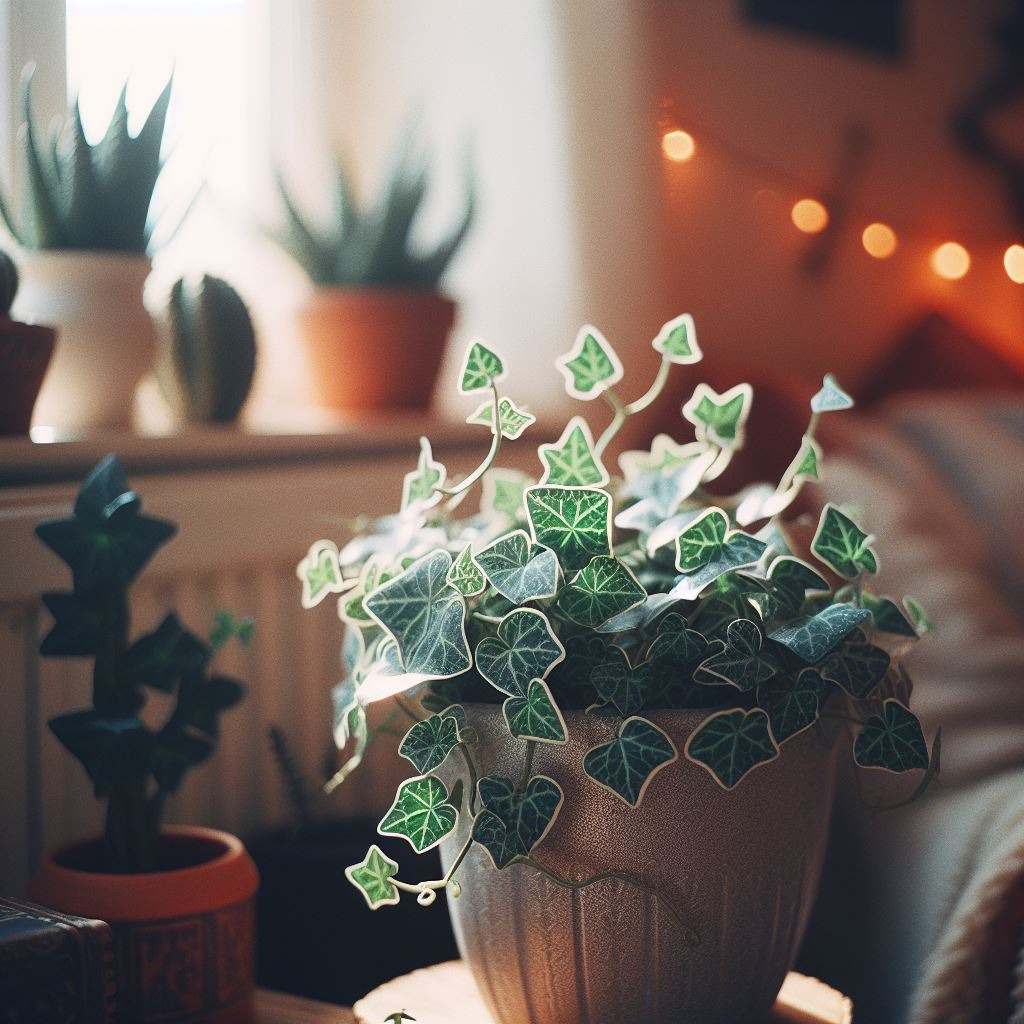Swedish Ivy, also known as Plectranthus australis, is a versatile and low-maintenance plant that can instantly transform your home into a lush oasis. With its air-purifying properties and ability to thrive indoors, is a popular choice for both seasoned gardeners and beginners. From creating the ideal temperature and humidity to incorporating it into your home decor, there are numerous benefits and creative ways to display Swedish Ivy. In this blog post, we’ll explore the various reasons why is the perfect addition to your indoor space.

Swedish Ivy (Plectranthus australis), originating from northern Australia and the Pacific Islands, is a popular hanging basket houseplant known for its elegant trailing habit. Also called Swedish begonia, this versatile plant is favored for both container gardening and groundcover use in gardens.
The glossy leaves feature delicately scalloped edges, enhancing its visual appeal. While tubular mauve to white flowers appear in spring through summer, the stunning foliage steals the spotlight. With easy-care attributes, Swedish Ivy is an ideal choice even for gardening beginners.
How to Growing Swedish Ivy Indoors: Cultivating a Swedish Ivy houseplant is easy. Opt for a light, loamy potting mix enriched with perlite for proper drainage. Place the plant in bright, indirect light for robust growth with minimal effort.
Care Tips for Swedish Ivy: Maintain a consistent room temperature between 60 and 75 degrees F (16-24 C). Water the plant weekly, allowing the soil to slightly dry between waterings. Ensure good drainage to prevent waterlogging. Feed the plant every two weeks in the growing season and monthly during fall and winter. Pinch off vine tips post-flowering for a compact shape. Repot every two to three years.
Propagation: For propagation, use healthy cuttings with a crown of leaves. Dip in rooting hormone and place in a container with potting medium. Optimal root development occurs in indirect sunlight. Mist cuttings or cover the pot with plastic for moisture. Roots should form within three weeks, giving rise to new plants. Transplant individual plants, discarding old leaves.
Elevate your indoor greenery with enchanting Swedish Ivy – where beauty meets simplicity in the world of houseplants.
Benefits of having Swedish Ivy in your home
is a popular houseplant that offers a range of benefits, making it a great addition to any home. Here are some reasons why incorporating Swedish Ivy into your living space can transform it into a lush oasis:
- Air Purification: is known for its air-purifying properties, helping to remove toxins from the air and improve indoor air quality. This can lead to a healthier and more pleasant living environment for you and your family.
- Low Maintenance: This plant is low-maintenance and easy to care for, making it an ideal choice for those with busy lifestyles or limited gardening experience. Its resilience and ability to thrive in various conditions make it a hassle-free addition to any home.
- Versatile Decor Element: Can be incorporated into various styles of home decor, whether you prefer a minimalistic, bohemian, or modern aesthetic. Its cascading foliage adds a touch of natural beauty to any space.
- Calming Atmosphere: The presence of greenery, such as Swedish Ivy, has been linked to reduced stress and anxiety. By introducing this plant into your home, you can create a calming and soothing atmosphere that promotes relaxation.
- Easy Propagation: Is easy to propagate, allowing you to expand your plant collection or share cuttings with friends and family. Watching new roots develop in water can be a rewarding experience for any plant enthusiast.
Incorporating Swedish Ivy into your home can bring numerous benefits, from enhanced air quality to aesthetic appeal, making it a worthwhile addition to your indoor environment.
How to Care for Swedish Ivy
Taking care relatively easy and requires minimal effort. Here are the essential care tips to ensure your thrives:
- Light: Place your Swedish Ivy in bright, indirect light. It can tolerate some degree of shade but prefers sunlight.
- Watering: Water the plant thoroughly, allowing the soil to dry out slightly between waterings. Overwatering can lead to root rot, so it’s crucial to maintain a proper watering schedule.
- Temperature and Humidity: Keep your Swedish Ivy in a room with a consistent temperature between 60-75°F (15-24°C) and moderate to high humidity. Misting the leaves can help create the ideal humidity level.
- Soil: Plant Swedish Ivy in well-draining, rich potting soil. A mix of peat moss, perlite, and regular potting soil works well.
- Fertilization: Fertilize the plant with a balanced liquid fertilizer once a month during the growing season (spring and summer).
- Pruning: Regularly pinch the tips of the plant to encourage bushier growth and remove any yellowing or leggy foliage.
By following these care guidelines, you can enjoy the beauty of Swedish Ivy in your home while keeping it healthy and thriving.

How to Grow Swedish Ivy Indoors
If you want to bring the lush beauty your home, here are some essential tips for successfully growing and nurturing this stunning plant indoors:
Light and Temperature Requirements
- Light: Place your Swedish Ivy in bright, indirect sunlight. It can also tolerate lower light conditions, but its growth may slow down.
- Temperature: Maintain a consistent indoor temperature between 60-75°F (15-24°C). Avoid placing the plant near drafts or extreme temperature changes.
Soil and Watering
- Soil: Plant in well-draining, high-quality potting soil to prevent waterlogging.
- Watering: Allow the top inch of the soil to dry out before watering. Overwatering can lead to root rot, so it’s essential to strike the right balance.
Fertilization
- Fertilize every 4-6 weeks during the growing season, using a balanced liquid fertilizer diluted to half strength.
Pruning and Maintenance
- Pruning: Regularly pinch back the growing tips to encourage full and bushy growth.
- Maintenance: Keep an eye out for any yellowing or leggy stems, and remove them to maintain a healthy appearance.
By following these indoor growing tips, you can ensure that your Swedish Ivy thrives and adds a touch of natural elegance to your home. Remember, patience and consistency are key when caring for this beautiful plant.
Ways to Incorporate Swedish Ivy into Your Home Decor
Swedish Ivy is not just a beautiful plant that adds a touch of nature to your indoor space; it can also be used in various creative ways to enhance your home decor. Here are some unique ideas to incorporate Swedish Ivy into your interior design:
- Hanging Baskets: Create an eye-catching display by hanging Swedish Ivy in stylish baskets from the ceiling. This not only adds a pop of greenery but also draws the eye upward, making the room feel more spacious.
- Vertical Gardens: Transform a blank wall into a stunning vertical garden by planting Swedish Ivy in wall-mounted containers. This unconventional approach to decorating not only looks fantastic but also maximizes space in smaller rooms.
- Table Centerpieces: Use a lush arrangement of Swedish Ivy as a centerpiece on your dining or coffee table. Pair it with candles or other decorative elements to create a charming focal point in any room.
- Terrariums: Incorporate Swedish Ivy into terrariums for a whimsical touch. They are easy to maintain and add a touch of green to any room without taking up much space.
By incorporating Swedish Ivy into your home decor, you can bring the beauty of nature indoors and create a calming and refreshing atmosphere throughout your living space.

Is Swedish Ivy Hard to Care For?
Taking care of Sh. Iy. is relatively easy, making it an excellent choice for both beginner and experienced indoor gardeners. Here’s why caring for Swedish Ivy is a breeze:
- Low Maintenance: is known for being a low-maintenance plant, requiring minimal care and attention.
- Water Requirements: It prefers slightly moist soil, so you don’t have to worry about watering it frequently. A good rule of thumb is to water it when the top inch of soil feels dry. This makes it a great option for individuals who have a busy schedule.
- Light Conditions: thrives in medium to bright indirect light, making it adaptable to various indoor environments. It can handle lower light conditions, but its growth may slow down.
- Temperature Tolerance: It can tolerate a wide range of temperatures, but it prefers to be in a relatively warm environment, ideally between 60-75°F (15-24°C). As long as you keep it away from drafts and sudden temperature changes, it will do just fine.
In conclusion, Sh. Iy. is not hard to care for and can easily thrive in most indoor settings with minimal attention. Its forgiving nature and resilience make it an ideal choice for anyone looking to add a touch of greenery to their home without the hassle of high maintenance plants.
Swedish Ivy’s Air-Purifying Properties
Swedish Ivy, also known as Plectranthus australis, goes beyond adding a touch of green to your home. This plant is an excellent addition to your indoor space due to its remarkable air-purifying properties. Here’s how Swedish Ivy can help improve the air quality in your home:
- Removal of Toxins: is effective at removing toxins such as formaldehyde from the air, which is commonly found in household products and furniture. This can contribute to a healthier indoor environment for you and your family.
- Natural Air Freshener: The plant releases a refreshing aroma, acting as a natural air freshener. This characteristic sets Sh. Iy. apart from traditional air-purifying systems by offering a more organic and visually appealing solution.
- Boosts Oxygen Levels: Like all plants, Sh. Iy. absorbs carbon dioxide and releases oxygen during the photosynthesis process. This natural exchange can enhance the oxygen levels in your home, promoting a fresher and more invigorating atmosphere.
Incorporating Sh. Iy. into your living space not only adds a decorative touch but also serves as a natural air purifier, benefiting your overall well-being.

The Versatility of Swedish Ivy in Different Rooms
Swedish Ivy is a versatile plant that can thrive in various rooms of your home, adding a touch of natural beauty and elegance to different spaces. Here’s how Sh. Iy. can be incorporated into different rooms:
1. Living Room
- Place a hanging basket of Swedish Ivy near a sunny window to create a vibrant focal point.
- Use Swedish Ivy as a trailing plant on a high shelf or as part of a greenery display.
2. Bedroom
- Swedish Ivy can be placed on a bedside table or a dresser to bring a calming and soothing ambiance to the room.
- Its air-purifying properties can contribute to better air quality for a restful sleep.
3. Bathroom
- Utilize Swedish Ivy in hanging planters or on shelves to add a spa-like atmosphere to the bathroom.
- The plant’s love for humidity makes it a perfect fit for this space.
4. Kitchen
- Display Swedish Ivy on the windowsill to benefit from its natural light requirements.
- Its trailing nature can also be utilized to add greenery to empty wall spaces.
5. Office or Study
- Swedish Ivy can thrive in the well-lit environment of an office, adding a touch of nature to the workspace.
- Its low-maintenance nature makes it a perfect choice for busy individuals.
In each of these rooms, Sh. Iy.not only adds aesthetic appeal but also contributes to a healthier indoor environment.
By strategically placing Sh. Iy. in different rooms, you can effectively transform your home into a lush oasis while enjoying the numerous benefits this versatile plant offers.
Creative ways to display Sh. Iy.
Swedish ivy is not only a beautiful plant to have in your home, but it also offers a great opportunity to get creative with your home decor. Here are some unique and creative ways to display Swedish ivy:
- Hanging Baskets: Hang your Sh. Iy. in beautiful macrame plant hangers to add a bohemian touch to your space.
- DIY Terrariums: Create your own terrarium using a clear glass container and fill it with layers of soil, pebbles, and Sh. Iy. for a stunning indoor garden display.
- Wall-mounted Planters: Install wall-mounted planters and let your Sh. Iy. cascade down the walls, adding a touch of greenery to your vertical space.
- Vintage Watering Cans: Repurpose vintage watering cans as planters for your Sh. Iy. to add a rustic and charming look to your home decor.
- Living Room Shelves: Place potted Swedish ivy on your living room shelves to bring a touch of nature indoors while adding a pop of green to your space.
- Teacup Planters: Upcycle old teacups and saucers as planters for your Swedish ivy, creating a whimsical and dainty display.
Incorporating House Plants into your home decor not only adds visual interest but also brings a sense of tranquility and natural beauty to your living spaces.

Creating the Ideal Temperature and Humidity
When it comes to creating the perfect environment for your Swedish Ivy to thrive, maintaining the right temperature and humidity levels is essential. Here’s how you can ensure the ideal conditions for your plant:
- Temperature: Thrives in average room temperatures, ranging from 60-75°F (15-24°C) during the day and shouldn’t fall below 50°F (10°C) at night. It’s important to avoid placing the plant near drafty areas or in direct contact with heating or cooling vents.
- Humidity: This plant enjoys higher humidity levels, so consider using a room humidifier if you live in a dry climate. Alternatively, you can place a tray filled with water and pebbles near the plant to increase the humidity around it.
- Avoid extremes: Keep your plants away from extreme temperature changes, such as cold drafts or sudden heat, as they can stress the plant and lead to problems.
By paying attention to these factors, you can create an environment that allows your Swedish Ivy to flourish and enhance the beauty of your home.
Sh. Iy. as a Low-Maintenance Plant
Sh. Iy. is an excellent choice for both experienced and novice plant owners due to its low-maintenance nature. Here are some reasons why Swedish Ivy is a hassle-free plant to have in your home:
- Watering: Is known for its resilience to occasional neglect, making it perfect for those who may forget to water their plants regularly. It thrives in slightly drier soil, so you won’t have to worry about overwatering it.
- Light Requirements: This plant can adapt to a variety of light conditions, including low light, making it versatile for any room in your home. It does best in bright, indirect light but can also tolerate lower light settings.
- Pruning: Responds well to pruning, making it easy to manage its size and shape. Regular pruning promotes bushier growth and keeps the plant looking tidy.
- Pest and Disease Resistance: Is relatively resistant to pests and diseases, reducing the need for extensive maintenance and treatments.
By choosing Swedish Ivy, you can enjoy the beauty of lush greenery in your home without the stress of high maintenance. Its forgiving nature and adaptability make it an ideal choice for anyone looking to add some green to their living space without the added maintenance effort.
Using houseplants to Create a Calming Atmosphere in Your Home
Swedish Ivy is not only a beautiful addition to your home decor, but it can also help create a tranquil and soothing atmosphere. Here are a few ways you can use Sh. Iy. to bring a sense of calm to your living space:
- Natural Stress Reliever: The lush green leaves of Sh. Iy. can provide a sense of tranquility, making it a perfect addition to spaces where you want to promote relaxation, such as a reading nook or a meditation area.
- Air Purification: The air-purifying properties of Swedish Ivy can contribute to a cleaner and healthier indoor environment, helping to reduce toxins and promote a sense of well-being.
- Aromatherapy: When touched, Swedish Ivy leaves release a mild, pleasing fragrance, adding a subtle aroma to your home that can contribute to a calming ambiance.
- Visual Appeal: Incorporating Sh. Iy. into your home decor can create a visually soothing ambiance, especially when combined with natural light and complementing decor elements.
By strategically placing Swedish Ivy in your home, you can transform the atmosphere into a calming sanctuary that promotes relaxation and well-being, making it a must-have plant for any interior space.
Potential Problems with Overwatering
Overwatering is a common issue when caring for S. Iy, as it is a plant that prefers to dry out between waterings. Here are some potential problems that may arise if you overwater your Swedish Ivy:
- Root Rot: Overwatering can lead to root rot, causing the roots to become mushy and discolored. This can ultimately lead to the death of the plant if not addressed promptly.
- Yellowing Leaves: Too much water can cause the leaves of houseplant to turn yellow and wilt. This is a sign of stress and can be a clear indicator of overwatering.
- Pest Infestation: Excessive moisture can attract pests such as fungus gnats and spider mites, which can further damage the plant.
To prevent these issues, it’s important to allow the top inch of the soil to dry out before watering again. Ensure that the pot has proper drainage and avoid leaving excess water in the saucer. Additionally, consider using a moisture meter to accurately gauge when your houseplant needs watering.
By being mindful of the watering needs of your Swedish Ivy, you can prevent potential problems and ensure that your plant thrives in its indoor environment.
Frequently Asked Questions
What is Swedish Ivy?
Swedish Ivy is a trailing houseplant with glossy, scalloped leaves that are green or variegated. It is known for its easy care and ability to thrive in low light conditions, making it a popular choice for indoor gardens.
How often should Swedish Ivy be watered?
Swedish Ivy prefers evenly moist soil, so it should be watered regularly when the top inch of the soil feels dry to the touch. However, it is important to avoid overwatering, as this can lead to root rot.
Can Swedish Ivy be grown outdoors?
Yes, Swedish Ivy can be grown outdoors in USDA hardiness zones 10-12. It prefers partial to full shade and well-draining soil. In cooler climates, it can be brought indoors during the winter months.
What are the benefits of having Swedish Ivy in the home?
Swedish Ivy is not only a beautiful decorative plant, but it also helps purify the air by removing toxins such as formaldehyde. Its lush foliage adds a touch of greenery to any space and contributes to a calming, serene atmosphere.
| Aspect | Care Information |
|---|---|
| Scientific Name | Plectranthus australis |
| Light Requirements | Bright, indirect light; can tolerate some shade. Avoid direct sunlight to prevent leaf burn. |
| Watering | Keep soil consistently moist. Water when the top inch of the soil feels dry. Reduce frequency in winter. |
| Soil Type | Well-draining mix of potting soil, perlite, and sand. |
| Temperature Range | 60-75°F (15-24°C). Avoid exposing to temperatures below 50°F (10°C). |
| Humidity Preferences | Enjoys higher humidity; maintain levels around 50-60%. Misting or using a humidifier can be beneficial. |
| Fertilization | Balanced liquid fertilizer every 4-6 weeks during the growing season (spring to early fall). |
| Pruning | Regular pruning to encourage bushier growth. Trim leggy stems and remove yellowing leaves. |
| Repotting Frequency | Every 1-2 years or when roots become root-bound. Use a slightly larger container with proper drainage. |
| Winter Care | Reduce watering frequency; monitor humidity as indoor heating can dry the air. Avoid drafts and cold temperatures. |
| Common Mistakes | Overwatering, insufficient light, using improper soil, neglecting pruning, and overfertilizing. |
| Pest Resistance | Relatively resistant to pests, including mealybugs and spider mites. Regularly inspect for pests. |
| Longevity | Perennial plant, capable of thriving for multiple years under optimal conditions. |
| Adaptability | Tolerant of various conditions, making it suitable for both beginners and experienced gardeners. |
| Decor Tips | Adds greenery to indoor spaces. Group with other houseplants to increase ambient humidity. |
| Health Indicators | Yellowing leaves may indicate overwatering. Pruning helps maintain overall plant health. |
EXPLORING THE ENCHANTING DIFFERENCES BETWEEN LOTUS AND WATER LILIES
Read More..






